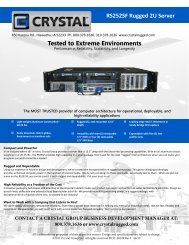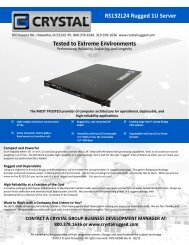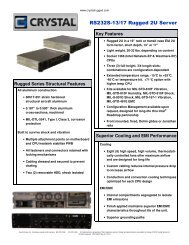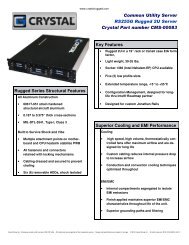Download our Current Deployments brochure [PDF] - Crystal Group
Download our Current Deployments brochure [PDF] - Crystal Group
Download our Current Deployments brochure [PDF] - Crystal Group
You also want an ePaper? Increase the reach of your titles
YUMPU automatically turns print PDFs into web optimized ePapers that Google loves.
<strong>Current</strong> <strong>Deployments</strong><br />
<strong>Crystal</strong> <strong>Group</strong> Inc, a veteran-owned small business, designs and manufactures deployment-ready, rugged<br />
servers, NAS and displays for mission critical applications. <strong>Crystal</strong> excels at providing commercial-off-<br />
<br />
designed and built to meet and exceed MIL-STDs 810F, 167-1, 461E, MIL-S-901D and beyond. <strong>Crystal</strong> <strong>Group</strong><br />
<br />
year warranties. Some of <strong>our</strong> current deployments include:<br />
Air Force<br />
ICAN<br />
ICAN (Interim Capability for Airborne Networking) is a Northrop Grumman program<br />
for the airborne platform that enables rapid and reliable communications with the<br />
Joint STARS program. The system works by routing data through existing radios<br />
to the DOD SIPRNET (secure network). <strong>Crystal</strong> <strong>Group</strong> provides rugged computer<br />
hardware to collect data transmitted between Army mobile ground station modules and Air Force E-8C aircraft becoming the<br />
com traffic gateway through the SIPRNET and NIPRNETs. <strong>Crystal</strong>’s CS100s (1U, short, commercial server) meets all of the<br />
ICAN program’s requirements for altitude, shock/vibration, thermal robustness, compact size and low power.<br />
ROBE<br />
ROBE (Roll-on Beyond Line of Sight Enhancement) is a TACCOM system<br />
developed to increase the global reach of the US Armed Forces. ROBE is a<br />
Northrop Grumman program funded out of Hanscom Air Force Base. The ROBE<br />
system was developed to rapidly establish a transportable tactical data link<br />
via tanker aircraft prior to engagement. The system is used as a node to relay<br />
C2, dataflow, and SITREP information to and from any location in the world using<br />
existing operational assets. <strong>Crystal</strong> <strong>Group</strong> provides the computer hardware (RS112<br />
- 1U rugged servers and RS376 - 3U rugged servers) that forms the backbone of the<br />
ROBE program. <strong>Crystal</strong> was selected because if its exceptional value by providing<br />
rugged hardware quickly and within budget.<br />
BACN<br />
BACN (Battlefield Airborne Communications Node) is a forward-deployed airborne<br />
communications relay and network-centric enterprise information server that<br />
allows real-time information exchanges among many different, distant military and<br />
commercial communications systems. BACN is designed for use in a variety of<br />
unmanned and manned aircraft, and is currently installed on a Global Express jet<br />
and NASA’s WB-57 high-altitude aircraft. The <strong>Crystal</strong> server CS100s was chosen<br />
for the combination of customizable form factors, with superior computing density.
www.crystalrugged.com<br />
Army<br />
DCGS-A<br />
The DCGS-A (Distributed Common Ground System) is an industry wide<br />
effort between General Dynamics C4 Systems, Northrop Grumman,<br />
Lockheed Martin, SAIC and <strong>Crystal</strong> <strong>Group</strong>. The effort is tasked with<br />
developing and integrating, manufacturing and delivering a fully armored,<br />
mobile intelligence network on the battlefield by interfacing with multiple<br />
nodes throughout the Net Centric DCGS collaborative intelligence<br />
operations. <strong>Crystal</strong> <strong>Group</strong>’s RS235 rugged server provides a compact form factor, rugged<br />
packaging, superior performance and ample feature set for the DCGS program.<br />
C-RAM<br />
The C-RAM program is a Counter Rocket, Artillery and Mortar (C-RAM) activity<br />
designed to help protect U.S. and coalition troops against mortars and rockets<br />
fired by insurgents. This system is a ground-based version of Phalanx together<br />
with the Army’s Lightweight Counter Mortar Radar (LCMR) and Q-36 Target<br />
Acquisition Radar. The Army uses <strong>Crystal</strong>’s RD2217 advanced liquid crystal<br />
dual displays to monitor and target incoming rocket and mortar threats with dual<br />
17" hi-res side by side displays which fit in a 2U space within a standard 19" rack<br />
or transit case. <strong>Crystal</strong> <strong>Group</strong>’s 17" dual display was chosen for its enhanced<br />
resolution, innovative rugged design and sunlight readability characteristics.<br />
Prophet<br />
The Army Prophet program uses <strong>Crystal</strong>'s RS112 server in a HMMWV based<br />
EW/SIGNET application. The Prophet is the Division and Armored Cavalry<br />
Regiment (ACR) commander's principal signals intelligence and electronic<br />
warfare system. It supports Force XXI and Army After Next (AAN) concepts<br />
by providing the commander with greatly enhanced situational awareness.<br />
The Prophet provides the Tactical Commander with an enhanced capability<br />
for electronic Intelligence Preparation of the Battlefield (IPB), battlespace<br />
visualization, target development and force protection. It gives the maneuver<br />
commander a comprehensive picture of the electronic emitters within the<br />
battlespace and provides the ability to locate, collect and electronically attack<br />
selected emitters where ground reconnaissance assets cannot penetrate or cover in a timely manner. Prophet gives the<br />
commanders a dedicated and dynamically re-taskable asset with the capability to look wide, as well as deep into their<br />
battlespace (150 kilometers wide by 120 kilometers deep). <strong>Crystal</strong> <strong>Group</strong>'s RS112 (1U rugged server) was chosen for the<br />
Prophet program for superior ruggedness, configuration management capability and overall value to the armed forces.
<strong>Current</strong> <strong>Deployments</strong><br />
Marines<br />
JECCS<br />
JECCS - Joint Enhanced Core Communications System - is a telecommunications<br />
system that allows deployed military personnel to establish voice, video and data<br />
network connectivity. JECCS provides telecommunication services, Local Area<br />
Network (SIPRNET and NIPRNET) and network management services, messaging<br />
services, INMARSAT and UHF-TACSAT capabilities. The system is designed to<br />
interface with SATCOM (T1 and T3) that extends its services over the horizon and<br />
provides reach back capabilities. It supports the seamless transition from a small<br />
force's command and control element to that of a larger force. The transition to<br />
larger telecommunications systems such as the Digital Technical Control (DTC),<br />
and the Tactical Data Network (TDN) are fully supported by JECCS. The JECCS<br />
is housed in a S788 shelter that is mounted in a M1097 Heavy High Mobility Multi-Wheeled Vehicle (HMMWV). Within this<br />
vehicle, <strong>Crystal</strong>'s CIS100X mobile network server is used to maintain reliable Net Centric data connectivity. The <strong>Crystal</strong><br />
CIS100X hardware was chosen in conjunction with <strong>Crystal</strong>'s integration capability to provide a total solution package for the<br />
Marine JECCS program.<br />
NASA<br />
WAVE<br />
WAVE (WB-57 Ascent Video Experiment) is an important safety aspect of NASA's<br />
Return to Flight program. WAVE provides high-resolution, high-speed, on-board<br />
video imaging data of the Space Shuttle during launch and landing operations. The<br />
imaging equipment is carried in the nosecones of NASA's WB-57 jets. The WB-57s<br />
operate at altitudes higher than 60,000 feet on missions as long as 6.5 h<strong>our</strong>s over<br />
2,500 miles at speeds as fast as 410 knots. WAVE uses <strong>Crystal</strong> <strong>Group</strong>'s CS500<br />
servers to capture detailed images of the Space Shuttle as it climbs toward orbit.<br />
The CS500 <strong>Crystal</strong> server is tested to MIL-STDs 810F and 167-1, indicating that it<br />
meets the requirements for altitude, humidity, shock and vibration as well as extended operational temperature ranges.<br />
SVG<br />
The Space Video Gateway (SVG) system uses live and recorded downlink<br />
capabilities to deliver High Definition (HD) and Standard Definition (SD) video<br />
streams from the International Space Station (ISS) to the Johnson Space Center.<br />
Footage transmitted from the ISS includes research information, educational<br />
footage, external and internal equipment inspection data, and communications<br />
from the crew. SVG uses <strong>Crystal</strong>'s CS900 server on the Space Station to receive<br />
HD and SD video from on-board cameras and downlink the video streams using a<br />
NASA-developed network card. The CS900 server is tested to MIL-STDs 810F &<br />
167-1 and MIL-S-901D, meeting the requirements necessary for a space based operational environment.
www.crystalrugged.com<br />
Navy<br />
GBS<br />
Global Broadcast Service (GBS) operates as a one-way, wideband transmission<br />
service capable of supporting timely delivery of classified and unclassified data<br />
and information products for mission support and theater information transfer.<br />
Basically like Direct TV for the war fighters! GBS disseminates IP-based realtime<br />
video and large data files (up to 4GB in size) over-the-air (30 Mbps per<br />
transponder) to garrisoned and deployed combat forces using smart push and user<br />
pull - information based on unit mission reception priority profiles. GBS operates<br />
from Satellite Broadcast Manager (SBM) sites, broadcast satellite payloads and<br />
receive suites (RS). A primary uplink site, through which information products are<br />
transmitted to the satellite for relay to forces over a large geographic area, serves<br />
each satellite. GBS also has the capability, through use of the Theater Injection<br />
Point (TIP), to inject information directly from within a theater of operations. The<br />
Navy uses <strong>Crystal</strong>'s CS100S to support the simultaneous broadcast of information<br />
to multiple war fighters using transportable receiver terminals on the ground and<br />
fixed receivers on surface and subsurface vessels. The <strong>Crystal</strong> <strong>Group</strong> CS100S<br />
server was chosen for its small form factor (1U, 17" depth), ability to handle shock<br />
(MIL-S-901D) and vibration (MIL-STD-167-1) and low noise levels (NMT 45dB).<br />
SSEE<br />
Ship's Signal Exploitation Equipment (SSEE) is a signals exploitation system that<br />
allows the operators to monitor and analyze signals of interest aboard a variety<br />
of ship classes. SSEE is the most modern and extensive communications intelligence<br />
system that is deployed on U.S. Navy surface ships. SSEE uses <strong>Crystal</strong> <strong>Group</strong>'s<br />
CS650MB (2U commercial) server and RS112 (rugged 1U) server for data processing.<br />
The servers were chosen for the combination of customizable form factors with superior<br />
computing capabity.
<strong>Current</strong> <strong>Deployments</strong><br />
Navy<br />
ALMDS<br />
Airborne Laser Mine Detection System (ALMDS) was developed by the US Navy<br />
to detect and classify floating and near-surface, moored mines. All ALMDS<br />
components are housed within a pod attached to the MH-60S helicopter. ALMDS<br />
uses <strong>Crystal</strong> <strong>Group</strong>'s RS232-SF rugged server as part of the communications<br />
system. The RS232-SF was chosen for its custom form factor, shallow depth and<br />
front I/O capability.<br />
RAMICS<br />
Rapid Airborne Mine Clearance System (RAMICS) is the detonation side of the<br />
ALMDS program. This platform uses a laser imaging and detecting system to<br />
reacquire moored mines and disable the mines from a safe distance, using a 30mm<br />
chain gun. RAMICS is integrated into the MH-60S helicopter to provide Carrier<br />
Battle <strong>Group</strong>s and Amphibious Ready <strong>Group</strong>s an organic mine countermeasures<br />
capability. The <strong>Crystal</strong> <strong>Group</strong> RS235 rugged server (2U) was chosen for its<br />
superior environmental performance including gun-fire vibration.<br />
DDG Modernization<br />
The DDG Modernization Program provides a comprehensive mid-life upgrade<br />
that will ensure the DDG 51 class vessel will maintain mission relevance and<br />
remain an integral part of the Navy's Sea Power 21 Plan. While manning and<br />
workload reduction have been designated as the primary objectives of the DDG<br />
modernization agenda, many of the proposed technologies also offer substantial<br />
improvements in the areas of situational awareness, survivability, and decision<br />
making. The network design, use of multi-function workstations, and distributed<br />
data acquistion improves the survivability of the system by allowing all smart<br />
and/or critical users to be redundantly connected. The goal of the DDG<br />
Modernization effort is to reduce manning requirements and increase situation awareness, survivability, and decision<br />
making while reducing total ownership cost to the Navy. The DDG Modernization technologies will be integrated during<br />
new construction of DDG 111 and 112, then retrofitted into DDG Flight I and II ships during in service overhaul periods. The<br />
DDG Mod program uses <strong>Crystal</strong> RS232-S13 & RS232-S17 rugged servers as part of the steering and navigations systems.<br />
The RS232-S13 and RS232-S17 servers were chosen for their custom and compact form factor as well as their superior<br />
thermal and acoustic performance.
www.crystalrugged.com<br />
Navy<br />
LCS<br />
Littoral Combat Ship (LCS) is a small specialized variant of the DD(X) family of<br />
future surface combat ships. The ships are easy to reconfigure for different roles,<br />
including anti-submarine warfare, mine countermeasures, anti-surface warfare,<br />
intelligence, surveillance and reconnaissance, homeland defense, maritime<br />
intercept, special operations, and logistics. <strong>Crystal</strong> <strong>Group</strong>'s RS232-SF rugged<br />
server (2U) is used in the ship's radar system. The RS232-SF was chosen for its<br />
custom form factor, shallow depth, front I/O capability and rugged features.<br />
ADNS and ISNS<br />
The Automated Digital Network System (ADNS) is a ship and shore<br />
communications network system. The system is based on a COTS, open<br />
architecture, worldwide communications network for Naval fleet communications.<br />
The system provides automated secure connectivity between shipboard LANs and<br />
piers, enables IT-21, IP/ATM and web hosting, video teleconferencing, battled<br />
encrypted email, common operational picture, tactical messaging, and routes<br />
defense messaging system traffic. The system is managed by the Space and<br />
Naval Warfare Systems Command (SPAWAR) in Charleston, NC. <strong>Crystal</strong>'s RS235<br />
2.66GHz Quad Core server was selected as the platform to host the ADNS<br />
program. The Integrated Shipboard Network System (ISNS), a subset of the ADNS,<br />
uses open architecture systems to outfit ships with a local and wide area network and also uses <strong>Crystal</strong>'s RS235 2.66GHz<br />
Quad Core server with ruggedized 1TB HDD's. These servers were chosen in this application for superior environmental<br />
performance and capability at a competitive price.<br />
CENTRIXS<br />
Combined Enterprise Regional Exchange System (CENTRIXS) allows U.S. forces<br />
to share information and operational planning. CENTRIXS creates an environment<br />
where information can be shared by various types of organizations, governments<br />
and vessels. CENTRIXS is the premier network for coalition interoperability in<br />
support of military operations. The <strong>Crystal</strong> <strong>Group</strong> RS112 (1U) Quad Core rugged<br />
server was chosen for use on these Navy applications due to its superior<br />
environmental performance and competitive price.
<strong>Current</strong> <strong>Deployments</strong><br />
Industrial Servers<br />
MANDIANT Intelligent Response (MIR)<br />
MANDIANT Intelligent Response is an enterprise-grade incident response<br />
solution, built from scratch by expert incident responders, engineers and IT<br />
security specialists. MIR enables precise data collection, advanced analysis and<br />
effective computer security incident management. Investigators can collaborate<br />
during response, analysis and reporting, making their response more efficient<br />
and cost effective. <strong>Crystal</strong> <strong>Group</strong> was selected to provide the hardware platform<br />
for this leading edge solution because of <strong>our</strong> unique engineering skills, rapid response capabilities and <strong>our</strong> ability to develop<br />
the exact server MANDIANT needed for this crucial security role. Features include custom injection molded faceplate, robust<br />
stainless steel chassis and unique removable drive arrangement. Learn more about MANDIANT Intelligent Response at:<br />
http://www.mandiant.com/intelligentresponse.htm<br />
<strong>Crystal</strong> <strong>Group</strong> Inc., 850 Kacena Road, Hiawatha, Iowa USA 52233<br />
Tel: 1.319.378.1636 FAX: 1.319.393.2338 1.800.378.1636 www.crystalrugged.com ISO 9001:2000<br />
All trademarks are properties of their respective owners. Design and specifications are subject to change. (C) 2009 <strong>Crystal</strong> <strong>Group</strong> Inc. All rights reserved. 01/09 Rev #2


![Download our Current Deployments brochure [PDF] - Crystal Group](https://img.yumpu.com/39975960/1/500x640/download-our-current-deployments-brochure-pdf-crystal-group.jpg)













